SOME LIKE IT HOT
Exotic Grapes
You’d think that I’d be over and done with the greenhouse this time of year. Spring vegetables and flowers have been germinated, pricked out, grown on, and all established in their homes in the garden.
But no, the greenhouse is still chock full of goodies, plants that tolerate heat. The first plant to jump out at you (visually) as you pass through the greenhouse door is a grape vine. Not just any old grape vine, but a vinifera grape vine (Vitis vinifera). “Vinifera” is the species of European wine and table grapes. They’re generally neither cold-hardy here, nor can they fend off attacks of our native insects and diseases, so have been hybridized with hardier and tougher American grape species, such as the fox grape (V. labrusca).
Point is, the grapevine in my greenhouse could not survive outdoors here. The variety I’m growing is Perle de Csaba, a table variety, which first fruited here a couple years ago; it’s seedless and sweet, with a strong aroma.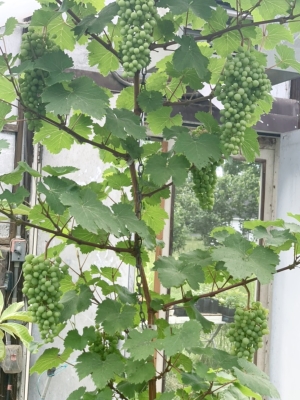
I grew it in a large pot, then didn’t move the pot, so it’s roots have sneaked out the pot’s drainage holes and into the moist, compost-enriched soil below. That’s fine. It’s in a good place, it’s stem now trained to climb up a chain to one of the greenhouse rafters. Short, fruiting shoots grow off up and down on either side of that permanent stem, a perfect bunch of grapes dangling from each of those shoots.
Moving on to . . .
Linger long enough by the grape vine and look to its right, and you come upon one of my failures, three cucumber plants, each trained vertically, just like the grape. I was hoping for early cukes, the variety Garden Oasis, but looks like the first of these won’t be ripe much sooner than outdoor cukes. No matter. Why? Follow me.
Moving on, at the foot of the next bed, you come upon a small tree in a pot: This is a dwarf plum tree that I made over the past two years by grafting a couple of varieties — Obilinaja and Oullin — onto a dwarfing rootstock. The tree could grow and potentially fruit outdoors except for pest problems, most notably brown rot, which turns ripening fruits into fuzzy gray dollops. That’s if the fruits make it that far; most are attacked early on by plum curculios, little, black, snout-nosed beetles that cause young fruits to drop. Both are common pests east of the Rocky Mountains.
My plan is to keep the tree in a pot in cold storage each winter, then move it into the greenhouse each year in late winter for early bloom, then early plums. In the greenhouse, the tree will not be threatened by late frosts, as was the large tree growing out in open ground. The greenhouse screens should keep curculios at bay and, I hope, spores of brown rot. All this may seem like a lot of trouble for the small crop expected from a small tree, but worth it if you’ve ever tasted a good variety of a dead ripe plum.
In the bed near that plum tree you’ll also come upon some grass-like stalks rising out of the ground. That’s ginger. In the past, I never could make sense as to why northern farmers were, I thought, wasting greenhouse space planting ginger. Then I gave them a try. The skinless, tender young rhizomes, perfect for slicing thinly then preserving in vinegar, are a far cry from the mature, fibrous ones available on supermarket shelves.
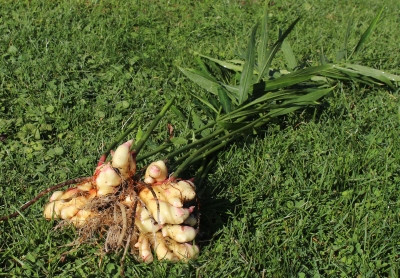
Last year’s ginger harvest
Are you still following me? Okay, at the foot of the next bed is another small tree, a mulberry. Mulberry trees abound almost everywhere; as you might have guessed, this is a special mulberry, Pakistani mulberry (Morus macroura). Its flavor is similar to black mulberry (M. nigra), whose flavor is so profoundly rich and sweet-tart that it seemingly could only have been packed into a much larger fruit.

Morus nigra, black mulberry
Besides having flavor that compares favorably with black mulberry, Pakistani mulberry can be up to five inches long, with a firmer texture, so keep better on or off a branch.
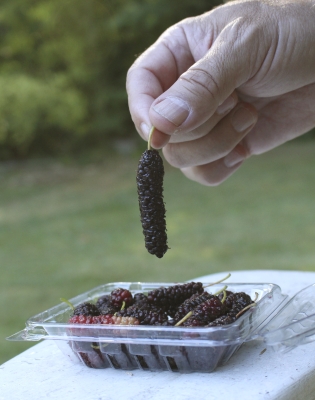
Pakistani mulberry
(Most of the mulberries you see throughout the country are white mulberry, M. alba, red mulberry, M. rubra, or hybrids of these two species. Their fruit color, despite their common names, can range anywhere from white to violet to red to black.)
Look to the right of that Pakistani mulberry tree and there’s more cucumbers, each plant trained like the previously mentioned cucumber vines to a single vertical stem. These plants — the variety Socrates — have been a success, yielding fresh cukes already for a few weeks.
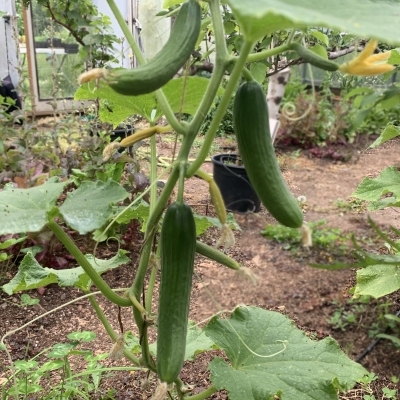
Greenhouse cucumbers, Socrates
Pièce de Résistance
Next comes the pièce de résistance, a fig espaliered against the rear wall of the greenhouse. It started the season, its 10th year, leafless with a single trunk about 18 inches high topped by a two burly, horizontal arms growing in opposite directions parallel to that rear wall. In the past few weeks, new shoots have grown vertically from those arms. Along those vertical shoots, figs have already swelled and will begin to ripen toward the end of August, or sooner.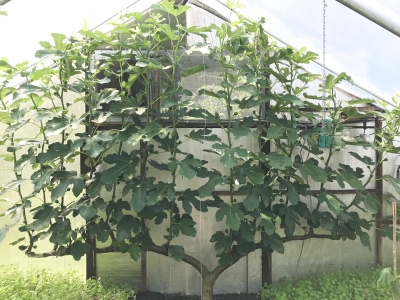
(I detail greenhouse growing and other methods not involving a greenhouse for growing figs in cold climates in my book titled, you guessed it, Growing Figs in Cold Climates.)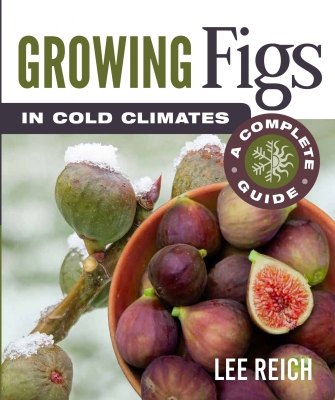
At the foot of the fig growing growing along the back wall of the greenhouse is a row of diminutive strawberry plants, alpine strawberries (Fragaria vesca), a different species than garden strawberries. They are dime-size, don’t make runners, and bear fruit as long as they have enough sun, heat, and water. They’ve been doing so since April. The variety, Pineapple Crush, ripens to a creamy white color, with dark seeds, and captures a strong aroma and flavor of strawberry with a wallop of pineapple.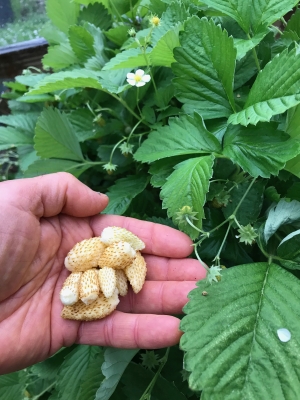
Heading Out
Let’s turn around and head back to the door. On the way there, to our right, we’ll pass three more figs, each of their short trunks capped by only a single horizontal arm per plant. The varieties are Excel, Brown Turkey, and San Piero, each different and each flavorful.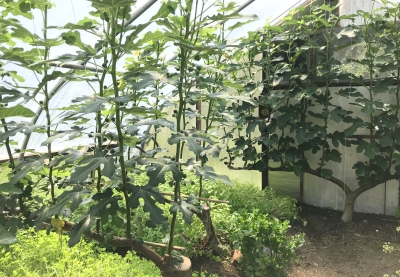
Before going out the door, glance to your left at a plant that was hiding behind the door when you entered. It’s the apricot variety of loquat. I don’t have high hopes about my picking a fruit from this plant. Loquat seems too gawky to keep small enough for my greenhouse and, as an evergreen, might shade too much in winter. Its gotta’ go.
All is not lost there because at the loquat’s feet grows the variety Earliglow of junebearing garden strawberries. Except, being in the greenhouse, they’ve been bearing since May and were losing steam just as Earliglow strawberries in the garden were picking up steam.
Except for the figs, these other fruits are recent additions to the greenhouse plant menagerie. The extravagance of having a greenhouse is softened by getting it to offer more bang for its buck — literally, for the dollars and cents it cost to feed the propane heater in winter (minimum temperature 37°F), and the electric cooling fan in summer (maximum temperature 110°F). Current offerings are fresh salads all winter, all my vegetable and flower seedlings in spring, strawberries in early spring, mulberries in late spring, grapes in midsummer, ginger in late summer, and figs in later summer and fall. That’s a lot of goodies from a space twenty feet by twenty feet, and, in my opinion, well worth the fun and food.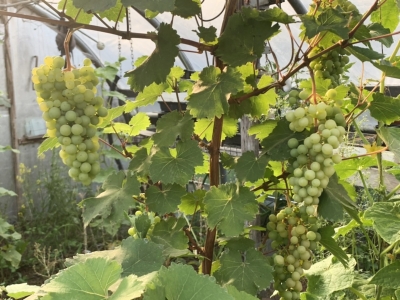


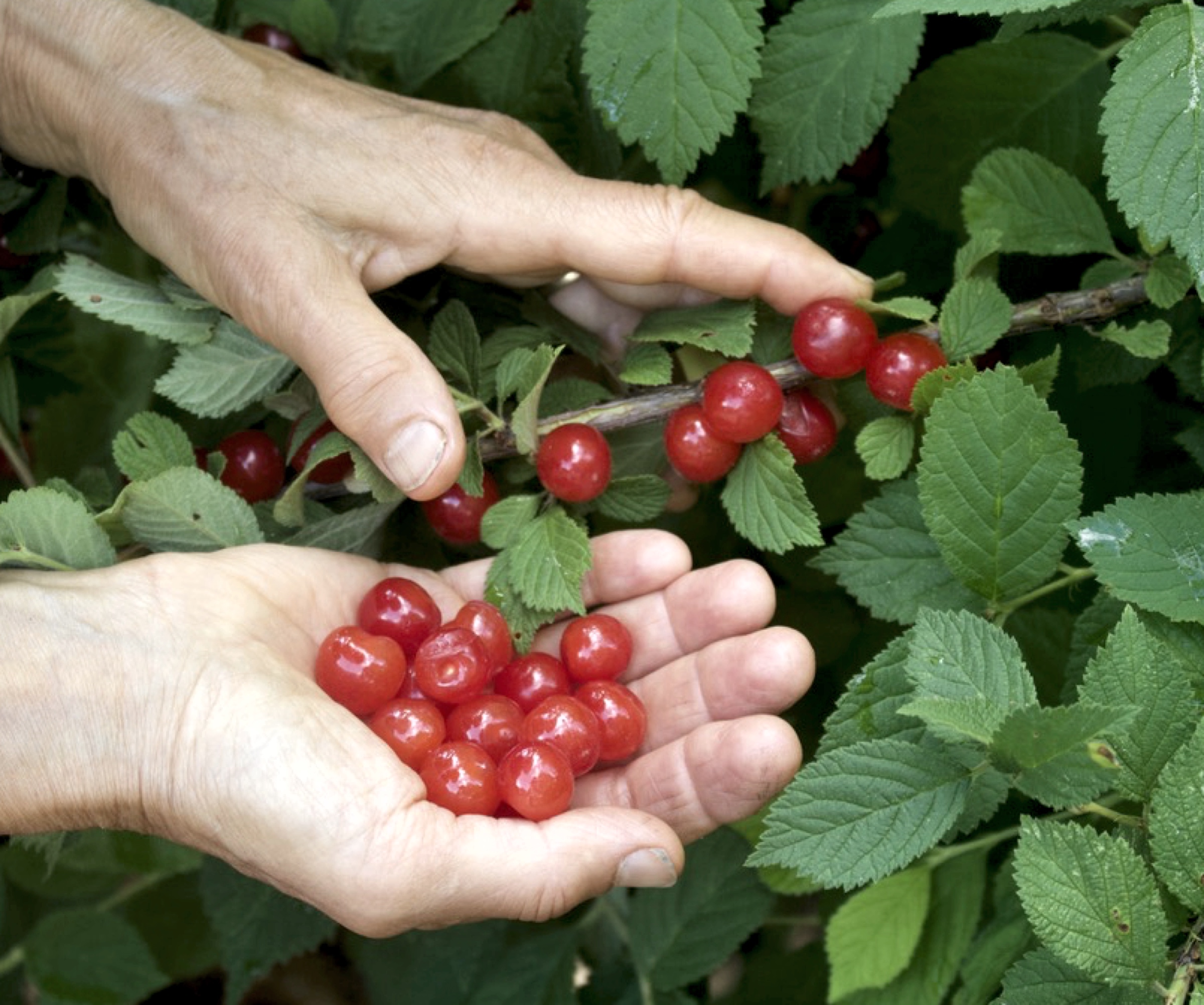
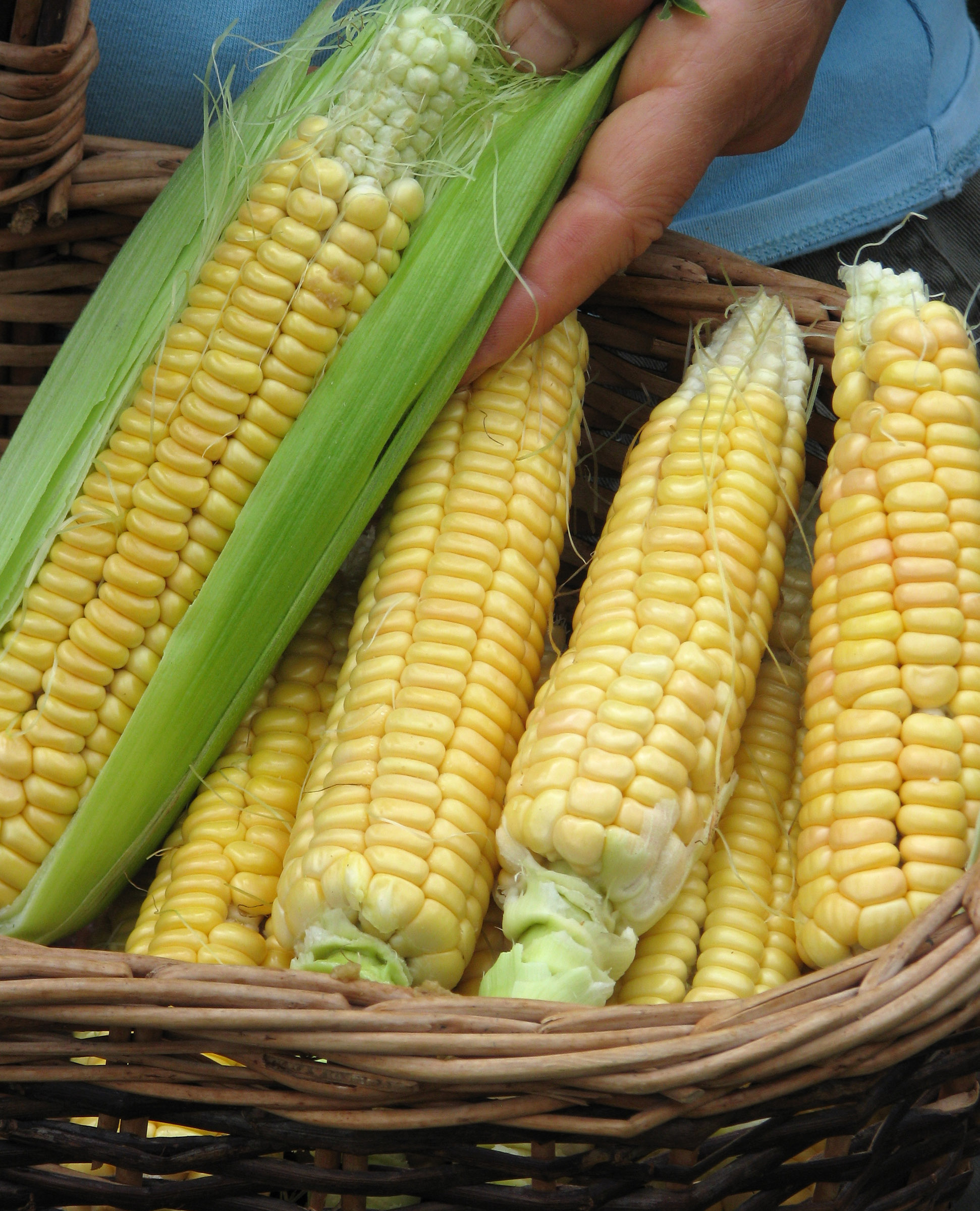
Lee what are the dimensions of your greenhouse? And how large is the espaliered fig on the end wall? I manage to kill my Brown Turkey over the winter (not girdled, protected from frost etc) so am looking to try to establish a fig ( or a grape) in my Zone 6b, unheated in the winter, greenhouse……
My greenhouse is 20 by 20 feet and it’s heated so temperature never drops below 37°in winter.
Lee, could you let us know the cultivar name of the dwarf ginger you cite? It seems like a winner even though we’ll need to bring it in each winter in NJ. Thanks, David Nial
PS we are having success with a fig ‘Sal’s Corleone’ leaving it in the ground with top protection against chilling/drying winds, in a US winter-hardiness zone of 7a.
It’s just any old ginger, not a dwarf. Up here out or the tropics, it doesn’t have time to mature. Lack of maturity is what makes it tender and skinless.
Zone 7a! Lots of figs should overwinter in that zone.